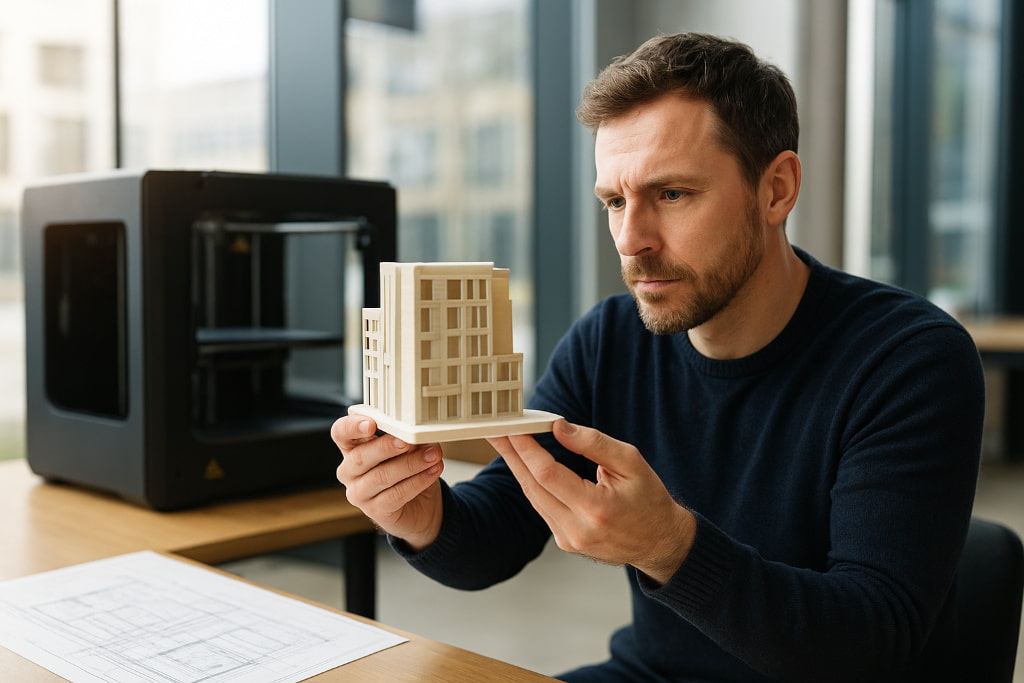
- +91 8055996347
- info@3dreality.in
- Chapru nagar square, CA road, Nagpur, Maharashtra-440008

Imagine standing before a towering skyscraper — not in a construction site with dust and noise, but inside a quiet studio, watching it rise layer by layer… from a 3D printer. Sounds futuristic? It’s not the future anymore. It’s happening now. And for architects, this isn’t just a new tool — it’s a revolution waiting to be harnessed.
3D printing has already shaken up manufacturing, medicine, and even fashion. But in architecture, it’s rewriting the rulebook. From rapid prototyping to printing entire homes, the technology is giving architects something they’ve never truly had before: complete creative freedom combined with speed.
So, which technologies are making the biggest impact? Let’s pull back the curtain on the top 5 3D printing technologies every architect should know — and trust me, the fifth one might just make you rethink the limits of your designs.
If 3D printing were a symphony, FDM would be the dependable percussion section — steady, versatile, and always in the mix. It works by heating and extruding thermoplastic filament, layer by layer, into a solid structure.
For architects, this means the ability to create scaled models in hours instead of days. Want to test how natural light falls into a proposed building? FDM lets you tweak, print, and see the results almost instantly.
The beauty lies in its cost-effectiveness and accessibility. Whether you’re working on a small residential project or experimenting with a bold real estate concept, FDM makes physical modeling easy — and affordable.
Ever looked at a model so precise it feels like it belongs in a museum? That’s SLA at work. This technology uses a UV laser to cure liquid resin into incredibly detailed and smooth structures.
For architectural presentations, SLA is your secret weapon. The level of precision allows you to showcase intricate façade patterns, delicate curves, and structural nuances that simply don’t translate on a screen.
It’s particularly useful for impressing clients who want to “feel” the detail — because when they hold that model, the vision becomes tangible. And in architecture, tangibility sells ideas faster than any slideshow.
Now we’re stepping into heavy-duty territory. SLS uses a high-powered laser to fuse powdered materials, creating parts that are not only complex but also extremely durable.
This makes it ideal for functional prototypes — think interlocking components, custom joints, or even large-scale structural parts. SLS is perfect for architects collaborating with engineers to test real-world performance before committing to full-scale construction.
And here’s the kicker: SLS doesn’t require support structures. That means you can print geometries that are otherwise impossible, letting your imagination stretch beyond traditional constraints.
If you believe architectural models should tell a story, binder jetting is your canvas. This technology layers powder material and binds it together with a liquid adhesive — and it can print in full color.
That means you can present a model with realistic textures, shading, and even landscaping. For competitions or investor presentations, color brings emotional connection, making your vision not just understood, but felt.
Imagine showing a scaled model of an urban development project where the streets, parks, and building materials are all vividly represented. You’re not just showing a plan; you’re showing a future city.
Here’s where the suspense pays off: contour crafting isn’t about models — it’s about printing entire buildings.
This large-scale 3D printing process uses a robotic arm to extrude concrete in layers, constructing walls and structures directly on-site. In real estate, this is groundbreaking. Imagine reducing construction time from months to days while maintaining precision and strength.
For architects, this isn’t just a new tool — it’s a shift in the very definition of building. It allows for organic shapes, energy-efficient designs, and cost savings that were once unimaginable. And the best part? This technology is already being tested to build sustainable housing in remote areas.
The line between imagination and creation is thinner than ever before. 3D printing isn’t just speeding up the design process — it’s changing how we design.
For architects, knowing these five technologies isn’t optional anymore; it’s essential. Each one offers unique advantages, and together, they open doors to possibilities the industry has never seen. Whether you’re designing a modest home or reimagining an entire skyline, these tools ensure your vision doesn’t stay trapped in a computer file.
Because in this new era of architecture, the question isn’t “Can it be built?’’ — it’s How soon can we print it?
Looking to bring advanced 3D printing into your architectural projects?
Contact 3DReality today — our expert team will help turn your boldest ideas into precise, stunning creations.